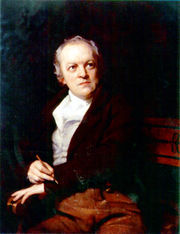 William Blake (1757-1827) was a British poet, painter, visionary mystic,
and engraver, who illustrated and printed his own books. Blake proclaimed the
supremacy of the imagination over the rationalism and materialism of the 18th-
century. Misunderstanding shadowed his career as a writer and artist and it was
left to later generations to recognize his importance.
William Blake (1757-1827) was a British poet, painter, visionary mystic,
and engraver, who illustrated and printed his own books. Blake proclaimed the
supremacy of the imagination over the rationalism and materialism of the 18th-
century. Misunderstanding shadowed his career as a writer and artist and it was
left to later generations to recognize his importance. Blake was born in London, where he spent most of his life. His father was a successful London hosier who encouraged Blake's artistic talents. Blake was first educated at home, chiefly by his mother. In 1767 he was sent to Henry Pars' drawing school. Blake has recorded that from his early years, he experienced visions of angels and ghostly monks and that he saw and conversed with the angel Gabriel, the Virgin Mary, and various historical figures.
At the age of 14 Blake was apprenticed for seven years to the engraver James Basire. Gothic art and architecture influenced him deeply. In 1783 he married Catherine Boucher, the daughter of a market gardener. Blake taught her to draw and paint and she assisted him devoutly.
Blake's first book of poems, Poetical Sketches, appeared in 1783 and was followed by Songs of Innocence (1789), and Songs of ExperienceE (1794). His most famous poem "The Tyger", was part of his Songs of Experience. In these works the world is seen from a child's point of view, but they also function as parables of adult experience.
Blake engraved and published most of his major works himself. Famous among his "Prophetic Books" are The Book of Thel(1789) The Marriage of Heaven and Hell,(1790) The Book of Urizen,(1794) America(1793), Milton(1804-8)and Jerusalem.(1804-20).In the "Prophetic Books", Blake expressed his lifelong concern with the struggle of the soul to free its natural energies from reason and organized religion. Among Blake's later artistic works are drawings and engravings for Dante's Divine Comedy and the 21 illustrations to the book of Job, which was completed when he was almost 70 years old.
Blake never shook off his economic poverty, which was in a large part due to his inability to compete in the highly competitive field of engraving and his expensive invention that enabled him to design illustrations and print words at the same time. However, independent throughout his life, Blake left no debts at his death on August 12, 1827. He was buried in an unmarked grave at the public cemetery of Bunhill Fields. Though generally dismissed as an eccentric during his lifetime, posterity rediscovered Blake and today he is highly rated both as a poet and artist.
http://www.online-literature.com/blake/
(Download)
(Download)
(Download)
